
Class 10 Geography NCERT: Comprehensive Guide on Soil as a Resource – Formation, Types, Conservation Practices
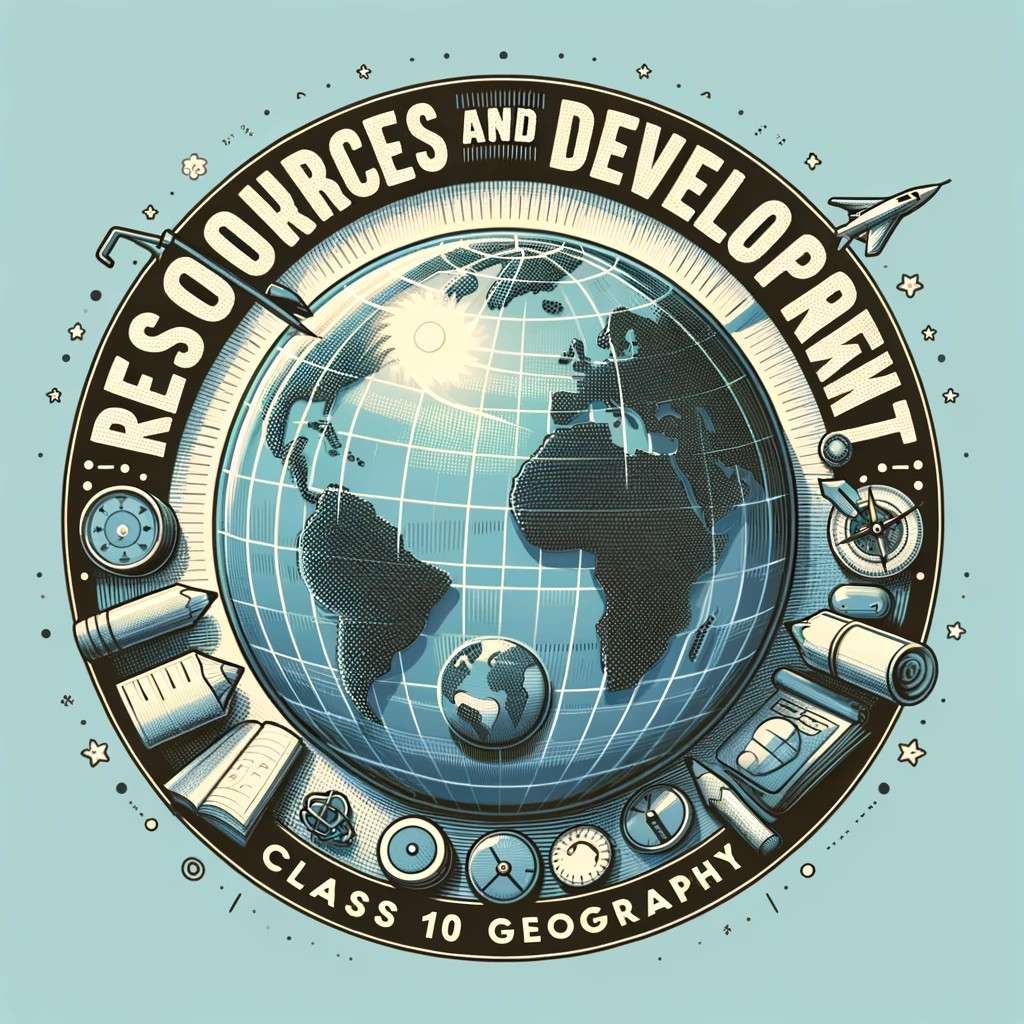
1. Introduction to Resources
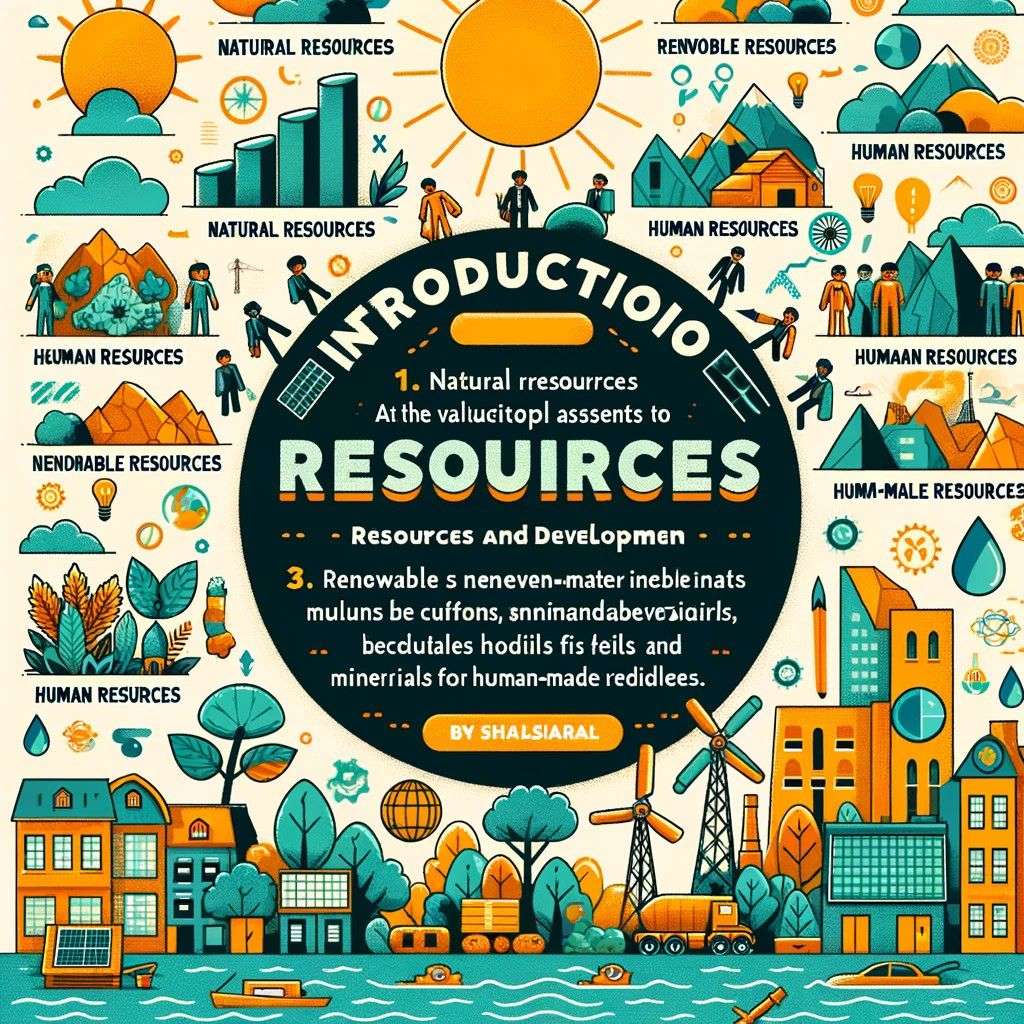
– Definition of Resources:
- In geography, resources refer to substances or assets that are valuable for human beings and can be used to fulfill our needs. They can be natural elements like water, air, minerals, or products created by humans. Essentially, a resource is anything that can be used to produce something else, provide utility, or satisfy a need.
– Types of Resources:
- Natural Resources: These are resources that exist without any actions of humankind. They can be found in the environment and are derived from the Earth. Examples include sunlight, water, air, minerals, forests, and wildlife.
- Human-made Resources: As the name suggests, these resources are created by humans using natural resources. They include buildings, machinery, vehicles, and technology. Human-made resources are essential for industrial and technological developments.
- Human Resources: Refers to the human population, including their skills, abilities, talents, and knowledge. Educated and healthy individuals are valuable resources as they contribute significantly to the economy and development of a country.
– Renewable vs Non-renewable Resources:
- Renewable Resources: These are resources that can be replenished naturally over time. They are not permanently depleted when used. Examples include solar energy, wind energy, and biomass. The key aspect of renewable resources is their sustainable nature as long as they are used responsibly.
- Non-renewable Resources: These resources have a limited supply and cannot be replenished naturally at a pace to keep up with consumption. Once used, they are depleted and cannot be used again. Examples include fossil fuels like coal, oil, and natural gas, and minerals like iron and gold. The finite nature of these resources makes them critical to manage wisely.
This section lays the groundwork for understanding how various types of resources play a pivotal role in development and why their sustainable management is crucial. It highlights the diversity of resources and emphasizes the need to balance their usage for long-term sustainability.
Certainly! Let’s explore the section on “Resource Development” in the “Resources and Development” chapter from Class 10 Social Science NCERT, focusing on Geography:
2. Resource Development
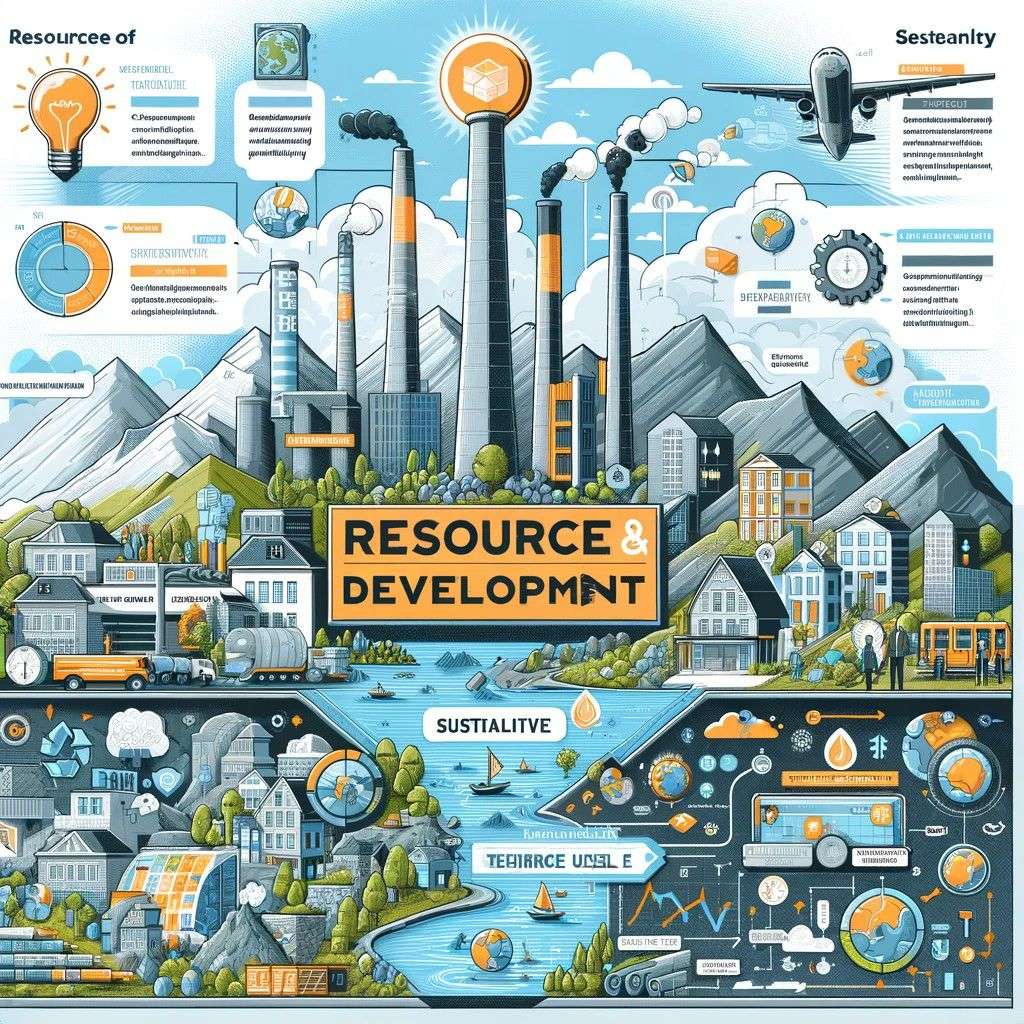
– Concept of Resource Development:
- Resource development refers to the process of increasing the utility of resources to meet human needs and aspirations. It involves the transformation of raw resources into valuable products and services. This process is not just about the extraction of resources but also encompasses their efficient and ethical utilization, management, and conservation. The aim is to maximize the benefits derived from resources while minimizing the negative impacts on the environment and society.
– Sustainable Resource Use:
- Sustainable resource use is a critical aspect of resource development. It means using resources in a way that meets present needs without compromising the ability of future generations to meet their own needs. This approach involves:
- Efficient utilization of resources to avoid wastage.
- Recycling and reusing resources wherever possible.
- Adopting technologies and practices that do not harm the environment.
- Considering the long-term impacts of resource use on ecological balance and biodiversity.
– Relationship between Nature, Technology, and Institutions:
- The development and management of resources involve a complex interplay between nature, technology, and institutions:
- Nature provides the raw materials in the form of natural resources.
- Technology determines the way resources are extracted, used, and conserved. Advancements in technology can lead to more efficient and sustainable resource utilization.
- Institutions (like governments, legal bodies, and educational organizations) play a crucial role in regulating and managing the use of resources. They set policies, laws, and guidelines that govern resource use, and are responsible for ensuring that resource development is equitable and sustainable.
Understanding the concept of resource development, the importance of sustainable use, and the relationship between nature, technology, and institutions is vital for effective and responsible management of resources. This holistic approach ensures that resources continue to support human well-being and economic development while preserving the environment.
3. Land Resources
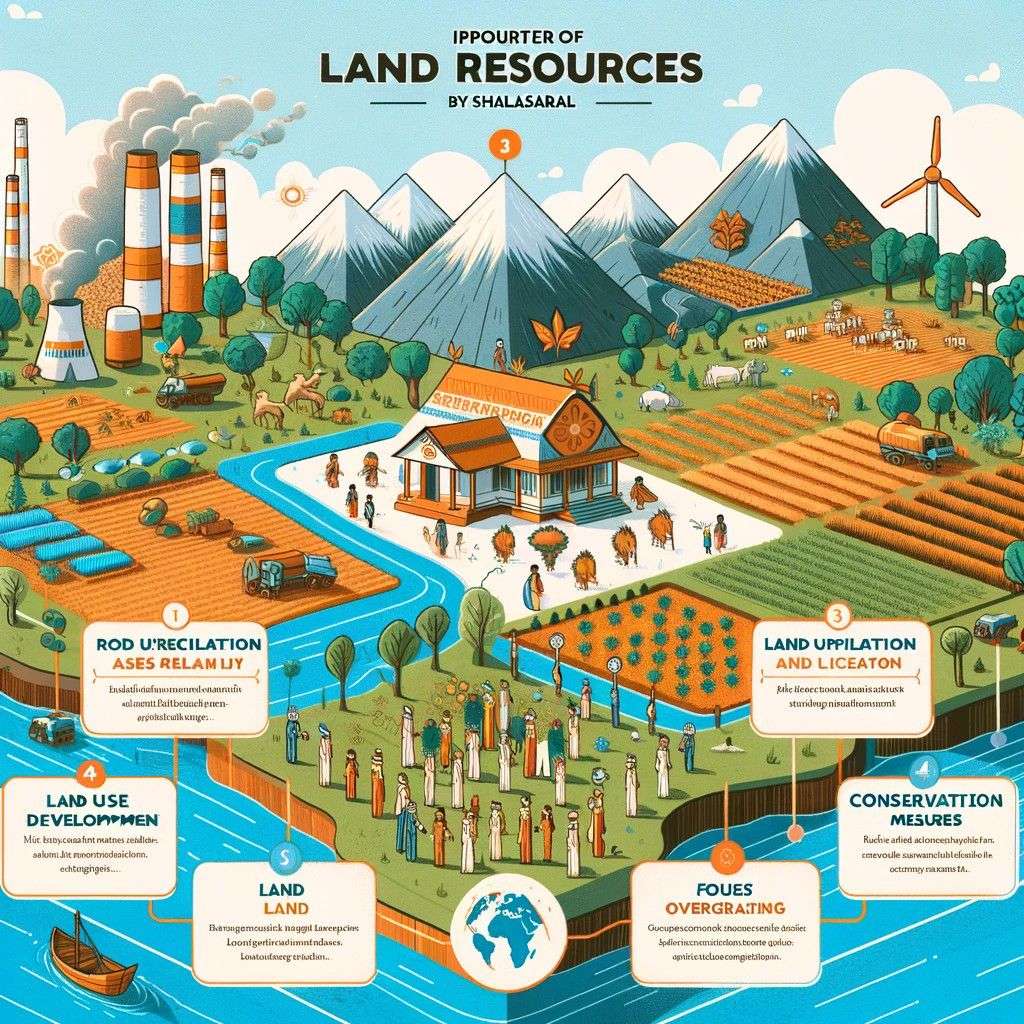
– Importance of Land as a Resource:
- Land is one of the most crucial natural resources. It supports natural vegetation, wildlife, human life, economic activities, transport, and communication systems.
- It provides space for agriculture, forestry, mining, building houses and roads, and setting up industries.
- The fertility of the land determines the type of vegetation and the extent of agricultural productivity.
– Land Utilization:
- Land utilization refers to the ways in which land is used in different regions.
- Factors affecting land use include the type of land, climate, availability of water, and human activities.
- Categories of land use include agricultural land, forest land, land used for housing and infrastructure, industrial purposes, and recreational areas.
– Land Use Pattern in India:
- India’s land use pattern is influenced by its topography, climate, soil types, and population.
- A significant portion of land is dedicated to agriculture, followed by forests.
- Other uses include land for pastures, housing, industry, and other non-agricultural purposes.
- The pattern also reflects regional variations due to different climatic conditions and population densities.
– Land Degradation and Conservation Measures:
- Land degradation is the deterioration of the earth’s land surfaces, often caused by human activities and natural processes.
- Causes include deforestation, overgrazing, overuse of chemical pesticides and fertilizers, and industrial activities.
- Conservation measures include afforestation, proper management of grazing, checking overuse of water resources, and adopting sustainable farming practices.
- Government and community initiatives play a crucial role in land conservation and preventing soil erosion.
In summary, land resources are fundamental to ecological balance, agricultural productivity, and economic development. Effective land utilization, understanding land use patterns, especially in a diverse country like India, and implementing measures for land conservation are vital for sustainable development.
Soil as a Resource
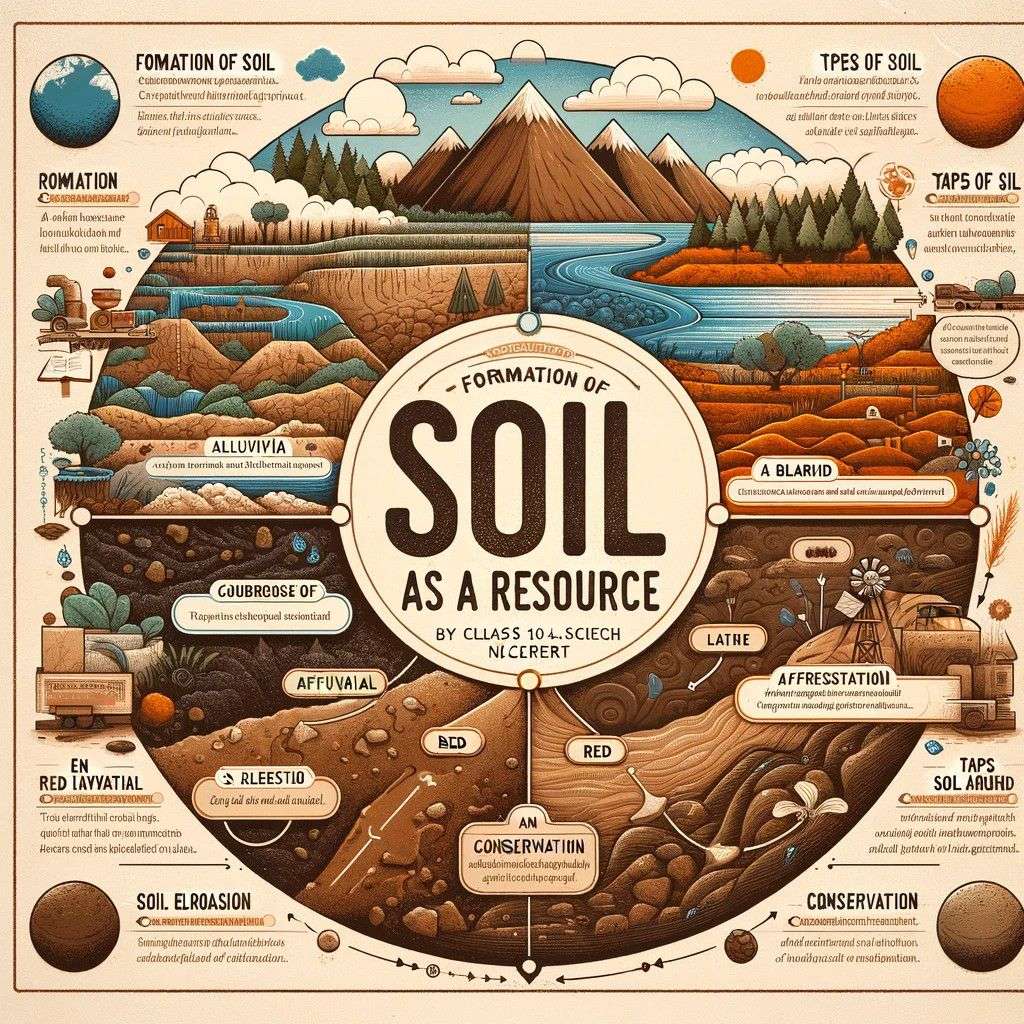
– Formation of Soil:
- Soil formation is a slow and complex process that involves the weathering of rocks and the decomposition of organic matter over thousands of years.
- Factors influencing soil formation include the nature of the parent rock, climate, vegetation, and various soil-forming processes.
- These processes result in the mixing of mineral particles with organic matter, leading to the creation of soil with distinct layers, known as soil horizons.
– Types of Soil:
- Soils vary greatly in composition, texture, structure, and color, leading to different types.
- Major types of soil in India include:
- Alluvial Soil: Fertile soil found in river basins and deltas. Suitable for a variety of crops.
- Black Soil: Rich in minerals and ideal for growing cotton. Found in Deccan Plateau.
- Red and Yellow Soil: Found in regions with a hot and moist climate, like the eastern and southern parts of the Deccan Plateau.
- Laterite Soil: Formed in areas with high rainfall. Used for growing tea and coffee.
- Arid Soil: Found in desert areas, with low organic matter.
- Forest Soil: Found in mountainous and forested areas, rich in humus.
- Each soil type has specific properties and is suitable for different kinds of crops and vegetation.
– Soil Erosion and Conservation:
- Soil erosion is the removal of the topsoil layer by wind, water, or human activities. It leads to a loss of fertile land and is a major environmental issue.
- Causes of soil erosion include deforestation, overgrazing, improper agricultural practices, and natural factors like heavy rain and wind.
- Conservation measures include:
- Afforestation and proper management of forests.
- Contour plowing, terrace farming, and using windbreaks in agricultural practices.
- Soil conservation techniques like mulching, building check dams, and adopting no-till farming.
- Effective soil conservation ensures the sustainability of agriculture and the protection of the environment.
Soil, as a resource, is vital for agriculture, ecosystems, and human survival. Understanding its formation, types, and the importance of preventing soil erosion is crucial for sustainable development and environmental conservation.
Natural Vegetation and Wildlife
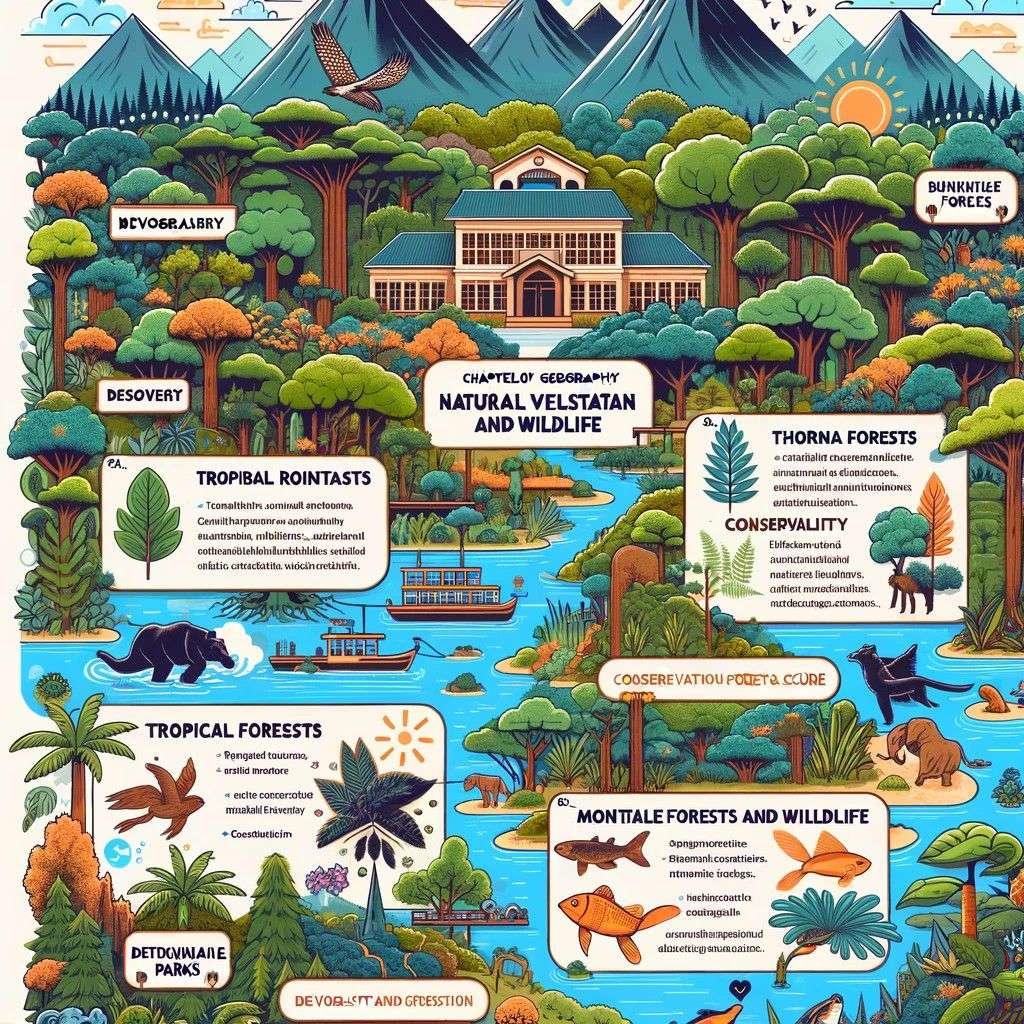
– Types of Natural Vegetation:
- Tropical Rainforests: Found in regions with high rainfall. Characterized by dense growth, a variety of species, and large trees.
- Tropical Deciduous Forests: Common in areas with seasonal rainfall. Trees shed leaves in the dry season to conserve water.
- Thorn Forests and Scrubs: Adapted to dry environments. Vegetation includes thorny trees and bushes.
- Montane Forests: Found in mountainous areas. Vegetation changes with altitude – from temperate forests to alpine vegetation.
- Mangrove Forests: Located in coastal areas and around deltas. Adapted to saline water.
– Conservation of Forest and Wildlife:
- Conservation includes protecting, preserving, and sustainably managing natural vegetation and wildlife.
- It involves the establishment of national parks, wildlife sanctuaries, and biosphere reserves.
- The focus is on protecting endangered species and their habitats, controlling poaching, and preventing deforestation.
– Biodiversity and its Conservation:
- Biodiversity refers to the variety of life forms on Earth, including different species of plants, animals, and microorganisms, the genetic differences among these species, and the ecosystems they form.
- Its conservation is essential for maintaining ecological balance and sustaining life on Earth.
- Measures include habitat conservation, ex-situ and in-situ conservation, reforestation, and the control of invasive species.
The preservation of natural vegetation and wildlife is crucial for ecological balance, environmental sustainability, and the well-being of all life forms on Earth. Biodiversity conservation ensures the resilience of ecosystems against environmental changes and human impacts.
Certainly! Let’s explore the section on “Water Resources” from the “Resources and Development” chapter in Class 10 Social Science NCERT, focusing on Geography:
Water Resources
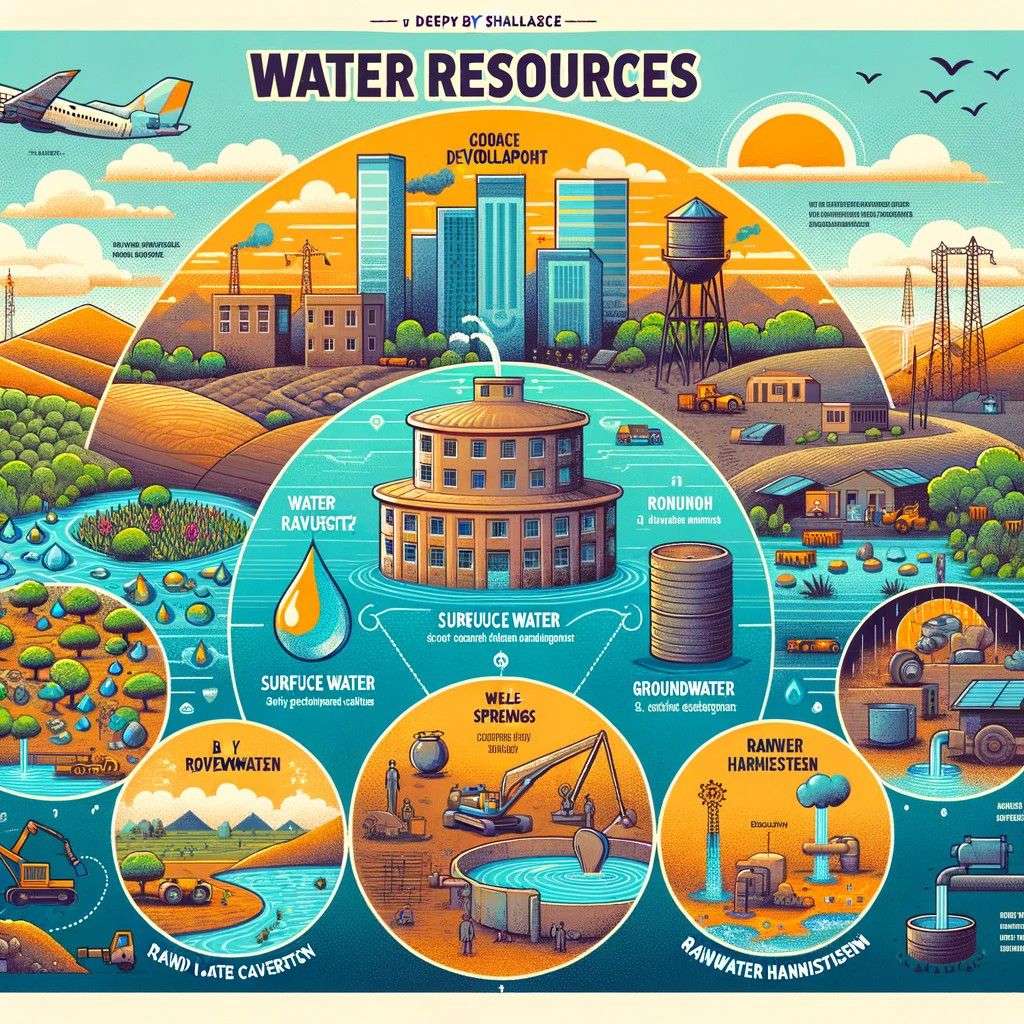
– Sources of Water:
- Water on Earth is found in various forms and locations, which include:
- Surface Water: Found in rivers, lakes, and reservoirs. It is the most accessible source of water for human use.
- Groundwater: Water stored beneath the Earth’s surface in soil pore spaces and in the fractures of rock formations. It is accessed through wells and springs.
- Rainwater: Water from precipitation that can be collected and stored.
- Oceans and Seas: Contain saltwater, which can be desalinated for use, though it’s an expensive process.
– Water Scarcity and The Need for Water Conservation and Management:
- Water scarcity is the lack of sufficient available water resources to meet the demands of water usage within a region. It can be due to overuse, pollution, or climate change.
- The need for water conservation and management arises to ensure a sustainable and equitable distribution of water.
- Strategies include:
- Reducing wastage and promoting efficient use of water in agriculture, industry, and households.
- Implementing policies to control water pollution and overuse.
- Creating awareness about the importance of water conservation.
– Rainwater Harvesting:
- Rainwater harvesting is the collection and storage of rainwater for reuse, rather than allowing it to run off.
- It can be done by collecting rainwater from rooftops, local catchments, and other surfaces.
- Benefits include reducing dependence on ground and surface water, mitigating urban flooding, and recharging groundwater levels.
Water resources are crucial for life, and their sustainable management is essential for maintaining the balance of ecosystems and meeting human needs. The conservation of water through methods like rainwater harvesting is increasingly important in the context of growing populations and changing climate conditions.
Mineral Resources
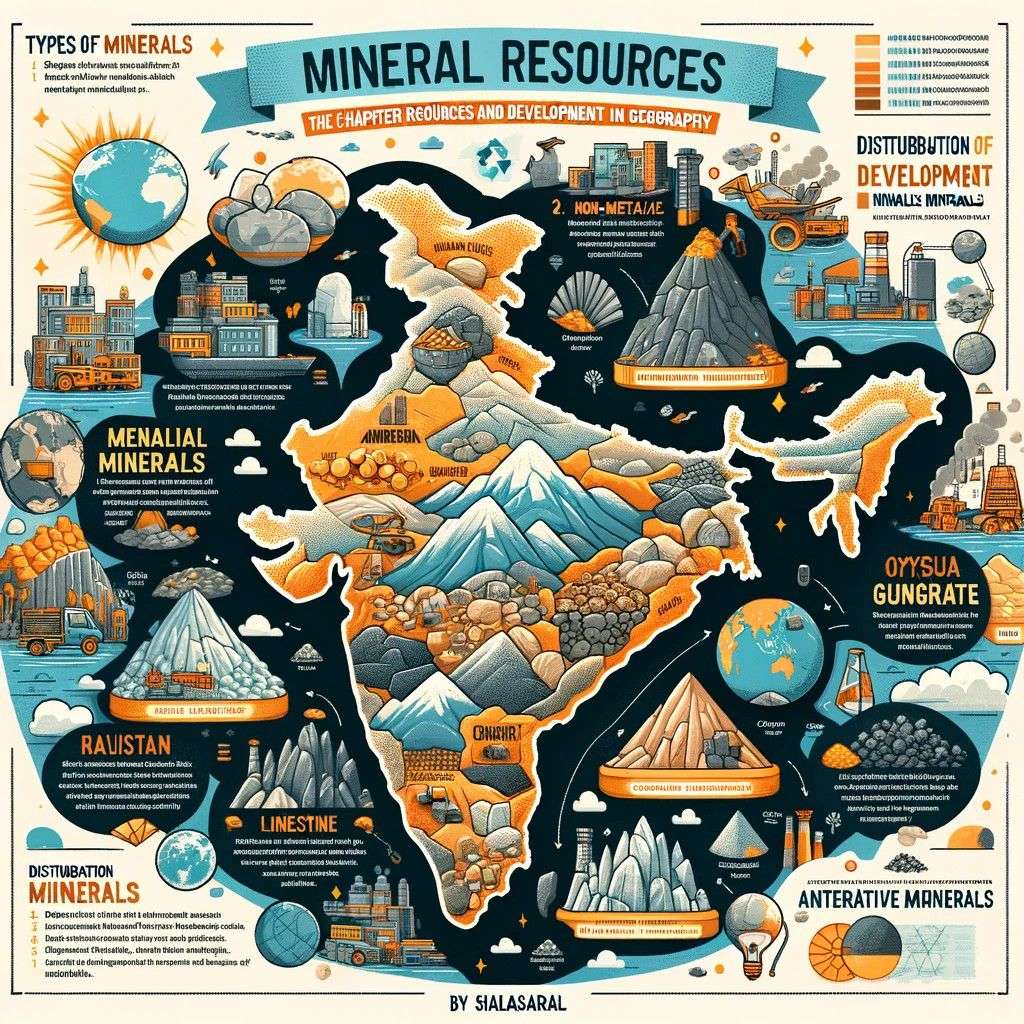
– Types of Minerals:
- Minerals are naturally occurring substances with a definite chemical composition. They are categorized into two main types:
- Metallic Minerals: These include minerals like iron, copper, bauxite, and gold. They are usually hard and have a shiny surface. Metallic minerals are further divided into ferrous (containing iron, like iron ore, manganese) and non-ferrous (not containing iron, like copper, lead).
- Non-metallic Minerals: These include minerals like limestone, gypsum, and phosphates. They do not contain metals and have more varied uses in industries.
– Distribution of Minerals in India:
- India is rich in mineral resources, and the distribution of these minerals is unevenly spread across different regions.
- Peninsular India: Rich in ferrous minerals and bauxite. The regions of Chota Nagpur plateau and the Odisha plateau are particularly rich in minerals.
- Rajasthan and Gujarat: Known for non-ferrous minerals.
- Northeastern Plateaus: Rich in mineral oil.
- The distribution is influenced by geological structures, processes, and the time period of formation of these minerals.
– Conservation and Use of Minerals:
- Mineral resources are finite and non-renewable. Thus, their conservation is essential.
- Conservation strategies include:
- Using minerals in a sustainable manner.
- Recycling metallic minerals.
- Developing alternative materials for industrial processes.
- Efficient mining practices to reduce wastage.
- The use of minerals involves extracting them from the Earth, which can impact the environment. Therefore, environmental-friendly extraction and processing are important.
Understanding mineral resources, their types, distribution, and the need for their conservation and sustainable use is crucial, especially in a country like India with vast and varied mineral deposits. This knowledge is key to the responsible management and utilization of these valuable resources.
Energy Resources
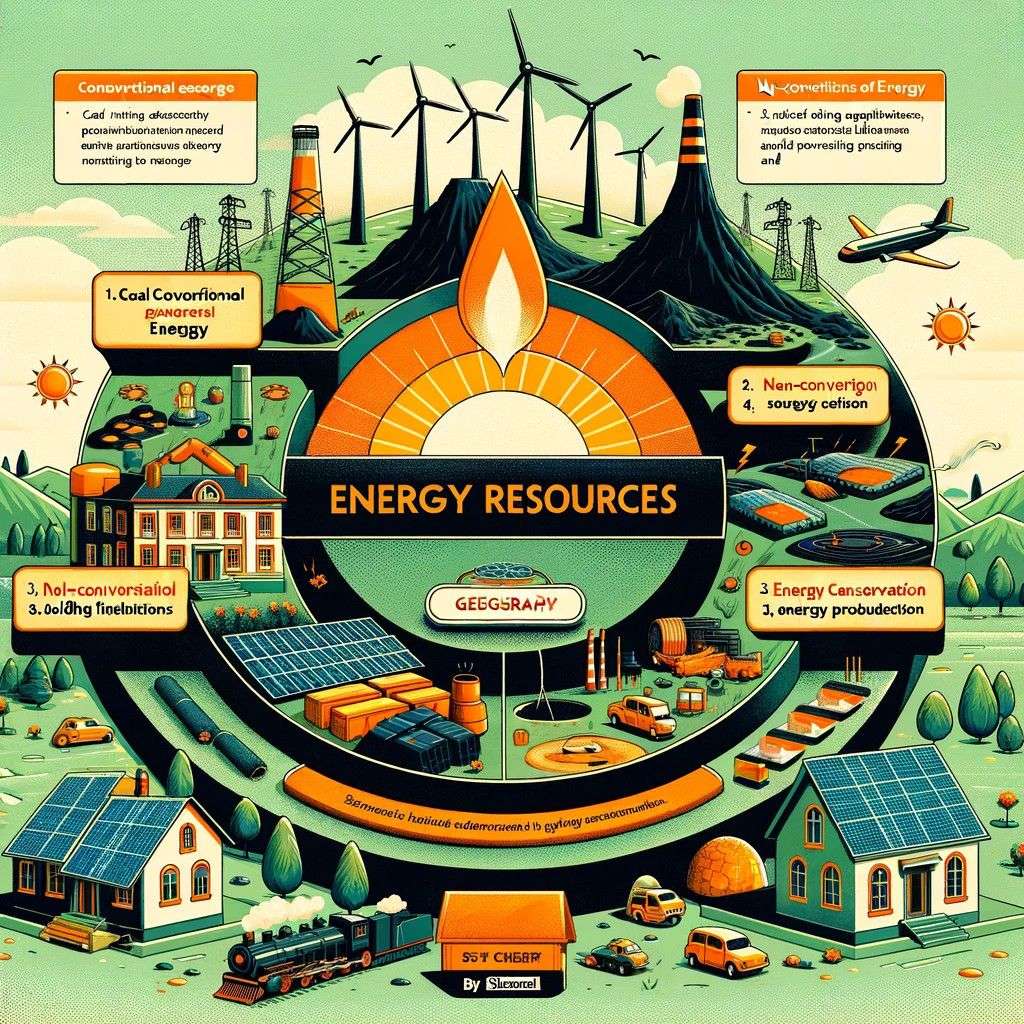
– Conventional Sources of Energy (Coal, Petroleum, Natural Gas):
- These are the traditional energy sources that have been used for many years.
- Coal: A fossil fuel used for electricity generation and in various industrial processes. It’s abundant but a major contributor to pollution and greenhouse gases.
- Petroleum: Also known as crude oil, it’s a liquid fossil fuel. Petroleum and its derivatives are used as fuel for vehicles, heating, and in the manufacturing of plastics.
- Natural Gas: Cleaner than other fossil fuels, it’s used for cooking, heating, and in power plants for electricity generation.
– Non-conventional Sources of Energy (Solar, Wind, Biomass):
- These are alternative energy sources that are renewable and more environmentally friendly.
- Solar Energy: Derived from the sun’s radiation. Solar panels convert sunlight into electricity. It’s renewable and abundant, with minimal environmental impact.
- Wind Energy: Generated by converting wind currents into electricity using wind turbines. It’s renewable and clean but depends on wind availability.
- Biomass: Comes from organic materials like plants, wood, and waste. It can be used to produce electricity, heat, or biofuels.
– Energy Conservation:
- It involves using less energy by adopting more efficient technologies and practices.
- Strategies include using energy-efficient appliances, improving insulation in buildings, and promoting public transportation.
- Energy conservation reduces the strain on natural resources and helps in combating environmental issues like climate change.
Understanding the different types of energy resources and the importance of energy conservation is crucial. While conventional energy sources are still dominant, the shift towards non-conventional, renewable sources is vital for sustainable and eco-friendly development. Energy conservation practices contribute significantly to this shift by reducing overall energy demand.
Planning and Sustainable Development in Indian Context
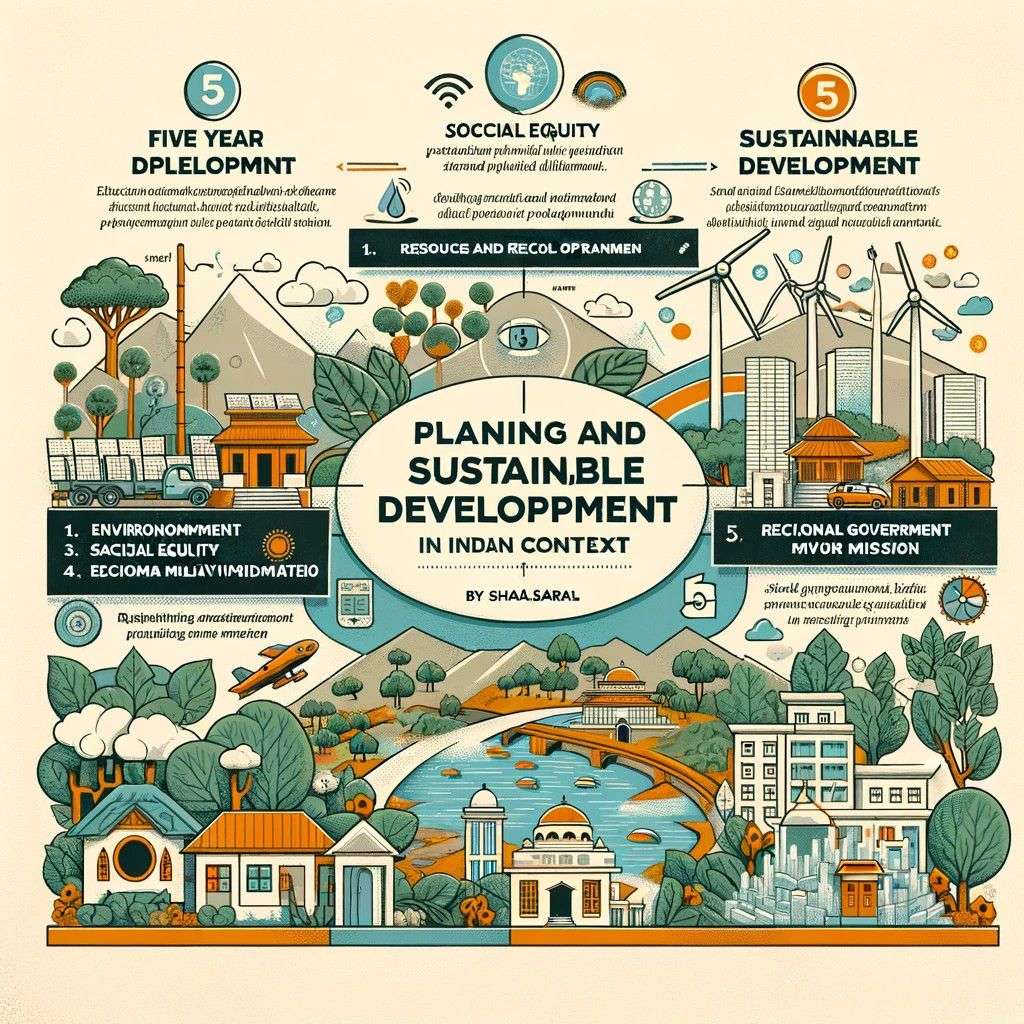
– Five Year Plans and Resource Development:
- Five Year Plans in India were a series of centralized and integrated national economic programs. Each plan aimed at achieving specific targets and growth objectives within a five-year period.
- These plans significantly focused on resource development, including the allocation of resources for agriculture, industry, energy, education, and health sectors.
- The objective was to ensure balanced and equitable distribution of resources to achieve socio-economic development.
– Sustainable Development:
- Sustainable Development is a holistic approach that seeks to meet the needs of the present without compromising the ability of future generations to meet their own needs.
- In India, this includes adopting practices that ensure environmental protection, social equity, and economic viability.
- Key areas include promoting renewable energy, sustainable agriculture, water conservation, and protection of natural habitats.
– Recent Government Initiatives:
- Various recent government initiatives reflect the commitment to sustainable development. Some key initiatives include:
- Swachh Bharat Abhiyan: A nationwide campaign to clean up streets, roads, and infrastructure.
- National Solar Mission: Aims to promote solar energy for power generation.
- Smart Cities Mission: Focuses on sustainable and inclusive urban development.
- Jal Jeevan Mission: Aims to provide safe and adequate drinking water through individual household tap connections.
- National Clean Air Programme (NCAP): Targets to reduce air pollution in major cities.
These components of planning and sustainable development in the Indian context highlight the country’s efforts to balance economic growth with environmental stewardship and social inclusivity. The shift towards more sustainable practices is evident in recent policies and initiatives, emphasizing India’s commitment to sustainable development goals.
Case Study: Sardar Sarovar Dam, India
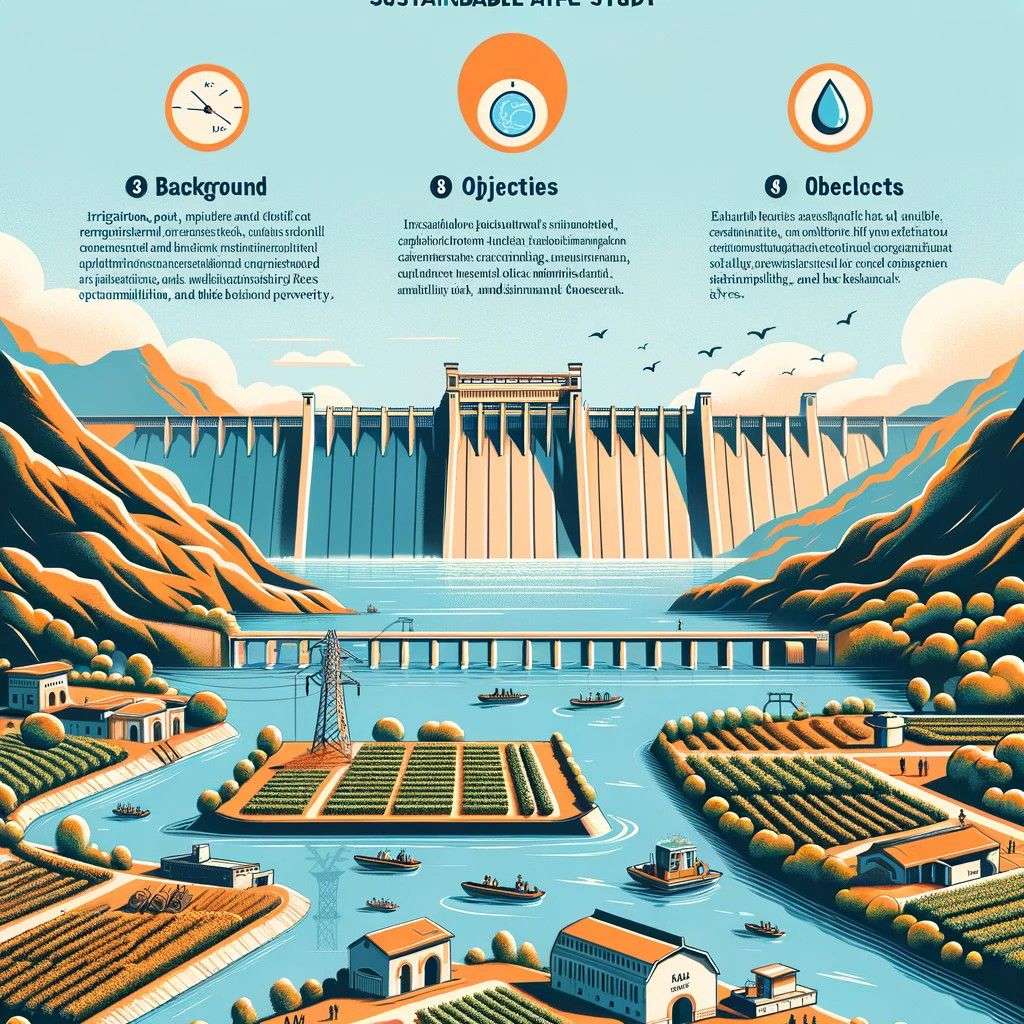
Background:
- The Sardar Sarovar Dam is one of the largest dams in the world and a part of the Narmada Valley Project, a major irrigation and water supply project in India.
Objectives:
- The primary objectives of the project were to provide irrigation, potable water, and hydroelectric power.
- The dam aimed to irrigate more than 18,000 square kilometers, most of it in drought-prone areas of Gujarat.
- It also aimed to supply water to arid regions of Gujarat and Rajasthan, and generate hydroelectric power.
Implementation:
- The construction of the dam began in 1987 and reached completion in 2017.
- The project included the creation of a large reservoir, canal systems, and hydroelectric power facilities.
Outcomes:
- Positive Impacts:
- The dam has significantly contributed to increased agricultural productivity in Gujarat.
- It provides drinking water to millions of people and supports over 9,000 villages and towns.
- Hydroelectric power generation has contributed to the energy supply in the region.
- Environmental and Social Challenges:
- The project faced controversy and protests over environmental concerns and the displacement of local communities.
- Rehabilitation of displaced people and environmental mitigation measures were significant challenges.
Lessons:
- The Sardar Sarovar Dam serves as a case study in the complexity of large-scale resource development projects.
- It highlights the balance between the benefits of resource utilization (like water supply, energy generation, and agricultural productivity) and the importance of addressing environmental and social impacts.
- The project underscores the need for comprehensive planning, stakeholder involvement, and sustainable practices in resource management.
This case study reflects the multifaceted nature of resource development, where economic development and environmental sustainability must be balanced carefully.